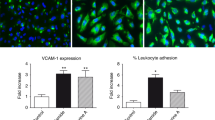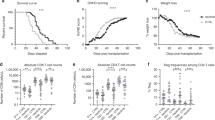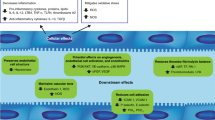Abstract
FTY720, an agonist for four of the five known sphingosine-1-phosphate (S1P) receptors, has been reported to inhibit acute graft-versus-host disease (aGVHD). Because FTY720 functions through multiple S1P receptors, the mechanism of action through one or more of these receptors may account for its side effects. Thus, more selective S1P receptor modulators are needed to evaluate the roles of different S1P receptors and their therapeutic efficacies. In this study, we investigated the effect of an S1P1-selective agonist, CYM-5442, on the progression of aGVHD. We showed that CYM-5442 significantly inhibited but did not prevent aGVHD. CYM-5442 did not affect the infiltration of the donor T cells into the target organs, while the number of macrophages in GVHD organs was significantly reduced by CYM-5442 treatment. In vivo proliferation assays showed that the proliferation of macrophages was not suppressed by CYM-5442. Further studies using human endothelial cells demonstrated that CYM-5442 treatment downregulated CCL2 and CCL7 expression in endothelial cells, therefore reducing the migration of monocytes, from which tissue macrophages originate. Our data demonstrate the therapeutic efficacy of an S1P1-selective agonist in aGVHD and its possible mechanism of action. The results suggest that further investigations are needed regarding CYM-5442 as a potential therapeutic regimen for aGVHD.
This is a preview of subscription content, access via your institution
Access options
Subscribe to this journal
Receive 12 digital issues and online access to articles
$119.00 per year
only $9.92 per issue
Buy this article
- Purchase on Springer Link
- Instant access to full article PDF
Prices may be subject to local taxes which are calculated during checkout





Similar content being viewed by others
References
Ferrara JL, Reddy P . Pathophysiology of graft-versus-host disease. Semin Hematol 2006; 43: 3–10.
Lee PY, Li Y, Kumagai Y, Xu Y, Weinstein JS, Kellner ES et al. Type I interferon modulates monocyte recruitment and maturation in chronic inflammation. Am J Pathol 2009; 175: 2023–2033.
Shlomchik WD . Graft-versus-host disease. Nat Rev Immunol 2007; 7: 340–352.
Allende ML, Dreier JL, Mandala S, Proia RL . Expression of the sphingosine 1-phosphate receptor, S1P1, on T-cells controls thymic emigration. J Biol Chem 2004; 279: 15396–5401.
Matloubian M, Lo CG, Cinamon G, Lesneski MJ, Xu Y, Brinkmann V et al. Lymphocyte egress from thymus and peripheral lymphoid organs is dependent on S1P receptor 1. Nature 2004; 427: 355–360.
Rivera J, Proia RL, Olivera A . The alliance of sphingosine-1-phosphate and its receptors in immunity. Nat Rev Immunol 2008; 8: 753–763.
Teijaro JR, Walsh KB, Cahalan S, Fremgen DM, Roberts E, Scott F et al. Endothelial cells are central orchestrators of cytokine amplification during influenza virus infection. Cell 2011; 146: 980–991.
Brinkmann V, Davis MD, Heise CE, Albert R, Cottens S, Hof R et al. The immune modulator FTY720 targets sphingosine 1-phosphate receptors. J Biol Chem 2002; 277: 21453–21457.
Mandala S, Hajdu R, Bergstrom J, Quackenbush E, Xie J, Milligan J et al. Alteration of lymphocyte trafficking by sphingosine-1-phosphate receptor agonists. Science 2002; 296: 346–349.
Paugh SW, Payne SG, Barbour SE, Milstien S, Spiegel S . The immunosuppressant FTY720 is phosphorylated by sphingosine kinase type 2. FEBS Lett 2003; 554: 189–193.
Zemann B, Kinzel B, Muller M, Reuschel R, Mechtcheriakova D, Urtz N et al. Sphingosine kinase type 2 is essential for lymphopenia induced by the immunomodulatory drug FTY720. Blood 2006; 107: 1454–1458.
Choi JW, Gardell SE, Herr DR, Rivera R, Lee CW, Noguchi K et al. FTY720 (fingolimod) efficacy in an animal model of multiple sclerosis requires astrocyte sphingosine 1-phosphate receptor 1 (S1P1) modulation. Proc Natl Acad Sci USA 2011; 108: 751–756.
Rosen H, Liao J . Sphingosine 1-phosphate pathway therapeutics: a lipid ligand-receptor paradigm. Curr Opin Chem Biol 2003; 7: 461–468.
Brinkmann V . FTY720: mechanism of action and potential benefit in organ transplantation. Yonsei Med J 2004; 45: 991–997.
Brinkmann V, Billich A, Baumruker T, Heining P, Schmouder R, Francis G et al. Fingolimod (FTY720): discovery and development of an oral drug to treat multiple sclerosis. Nat Rev Drug Discov 2010; 9: 883–897.
Brinkmann V, Wilt C, Kristofic C, Nikolova Z, Hof RP, Chen S et al. FTY720: dissection of membrane receptor-operated, stereospecific effects on cell migration from receptor-independent antiproliferative and apoptotic effects. Transplant Proc 2001; 33: 3078–3080.
Chiba T, Yokosuka O, Goto S, Fukai K, Imazeki F, Kohno Y et al. Clinicopathological features in patients with hepatic graft-versus-host disease. Hepatogastroenterology 2005; 52: 1849–1853.
Hashimoto D, Asakura S, Matsuoka K, Sakoda Y, Koyama M, Aoyama K et al. FTY720 enhances the activation-induced apoptosis of donor T cells and modulates graft-versus-host disease. Eur J Immunol 2007; 37: 271–281.
Kataoka H, Sugahara K, Shimano K, Teshima K, Koyama M, Fukunari A et al. FTY720, sphingosine 1-phosphate receptor modulator, ameliorates experimental autoimmune encephalomyelitis by inhibition of T cell infiltration. Cell Mol Immunol 2005; 2: 439–448.
Kim YM, Sachs T, Asavaroengchai W, Bronson R, Sykes M . Graft-versus-host disease can be separated from graft-versus-lymphoma effects by control of lymphocyte trafficking with FTY720. J Clin Invest 2003; 111: 659–669.
Yopp AC, Ledgerwood LG, Ochando JC, Bromberg JS . Sphingosine 1-phosphate receptor modulators: a new class of immunosuppressants. Clin Transplant 2006; 20: 788–795.
Budde K, Schmouder RL, Nashan B, Brunkhorst R, Lücker PW, Mayer T et al. Pharmacodynamics of single doses of the novel immunosuppressant FTY720 in stable renal transplant patients. Am J Transplant 2003; 3: 846–854.
Forrest M, Sun SY, Hajdu R, Bergstrom J, Card D, Doherty G et al. Immune cell regulation and cardiovascular effects of sphingosine 1-phosphate receptor agonists in rodents are mediated via distinct receptor subtypes. J Pharmacol Exp Ther 2004; 309: 758–768.
Gonzalez-Cabrera PJ, Jo E, Sanna MG, Brown S, Leaf N, Marsolais D et al. Full pharmacological efficacy of a novel S1P1 agonist that does not require S1P-like headgroup interactions. Mol Pharmacol 2008; 74: 1308–1318.
Lo CG, Xu Y, Proia RL, Cyster JG . Cyclical modulation of sphingosine-1-phosphate receptor 1 surface expression during lymphocyte recirculation and relationship to lymphoid organ transit. J Exp Med 2005; 201: 291–301.
Keul P, Lucke S, von Wnuck Lipinski K, Bode C, Graler M, Heusch G et al. Sphingosine-1-phosphate receptor 3 promotes recruitment of monocyte/macrophages in inflammation and atherosclerosis. Circ Res 2011; 108: 314–323.
Massberg S, von Andrian UH . Fingolimod and sphingosine-1-phosphate—modifiers of lymphocyte migration. N Engl J Med 2006; 355: 1088–1091.
Tolle M, Levkau B, Keul P, Brinkmann V, Giebing G, Schonfelder G et al. Immunomodulator FTY720 Induces eNOS-dependent arterial vasodilatation via the lysophospholipid receptor S1P3. Circ Res 2005; 96: 913–920.
Tolle M, Pawlak A, Schuchardt M, Kawamura A, Tietge UJ, Lorkowski S et al. HDL-associated lysosphingolipids inhibit NAD(P)H oxidase-dependent monocyte chemoattractant protein-1 production. Arterioscler Thromb Vasc Biol 2008; 28: 1542–1548.
Fujino M, Funeshima N, Kitazawa Y, Kimura H, Amemiya H, Suzuki S et al. Amelioration of experimental autoimmune encephalomyelitis in Lewis rats by FTY720 treatment. J Pharmacol Exp Ther 2003; 305: 70–77.
Martini S, Kramer S, Loof T, Wang-Rosenke Y, Daig U, Budde K et al. S1P modulator FTY720 limits matrix expansion in acute anti-thy1 mesangioproliferative glomerulonephritis. Am J Physiol Renal Physiol 2007; 292: F1761–F1770.
Rausch M, Hiestand P, Foster CA, Baumann DR, Cannet C, Rudin M . Predictability of FTY720 efficacy in experimental autoimmune encephalomyelitis by in vivo macrophage tracking: clinical implications for ultrasmall superparamagnetic iron oxide-enhanced magnetic resonance imaging. J Magn Reson Imaging 2004; 20: 16–24.
Zhang Z, Zhang ZY, Fauser U, Schluesener HJ . FTY720 ameliorates experimental autoimmune neuritis by inhibition of lymphocyte and monocyte infiltration into peripheral nerves. Exp Neurol 2008; 210: 681–690.
Hla T, Venkataraman K, Michaud J . The vascular S1P gradient-cellular sources and biological significance. Biochim Biophys Acta 2008; 1781: 477–482.
Hill GR, Cooke KR, Teshima T, Crawford JM, Keith JC Jr, Brinson YS et al. Interleukin-11 promotes T cell polarization and prevents acute graft-versus-host disease after allogeneic bone marrow transplantation. J Clin Invest 1998; 102: 115–123.
Robb RJ, Hill GR . The interferon-dependent orchestration of innate and adaptive immunity after transplantation. Blood 2012; 119: 5351–5358.
Gonzalez-Cabrera PJ, Cahalan SM, Nguyen N, Sarkisyan G, Leaf NB, Cameron MD et al. S1P1 receptor modulation with cyclical recovery from lymphopenia ameliorates mouse model of multiple sclerosis. Mol Pharmacol 2012; 81: 166–174.
Poti F, Costa S, Bergonzini V, Galletti M, Pignatti E, Weber C et al. Effect of sphingosine 1-phosphate (S1P) receptor agonists FTY720 and CYM5442 on atherosclerosis development in LDL receptor deficient (LDL-R−/−) mice. Vascul Pharmacol 2012; 57: 56–64.
Huu DL, Matsushita T, Jin G, Hamaguchi Y, Hasegawa M, Takehara K et al. FTY720 ameliorates murine sclerodermatous chronic graft-versus-host disease by promoting expansion of splenic regulatory cells and inhibiting immune cell infiltration into skin. Arthritis Rheum 2013; 65: 1624–1635.
Song J, Ito T, Matsuda C, Miao G, Tanemura M, Nishida T et al. Inhibition of donor-derived T cells trafficking into target organs by FTY720 during acute graft-versus-host disease in small bowel transplantation. Clin Exp immunology 2006; 146: 85–92.
Taylor PA, Ehrhardt MJ, Lees CJ, Tolar J, Weigel BJ, Panoskaltsis-Mortari A et al. Insights into the mechanism of FTY720 and compatibility with regulatory T cells for the inhibition of graft-versus-host disease (GVHD). Blood 2007; 110: 3480–3488.
Toubai T, Shono Y, Nishihira J, Ibata M, Suigita J, Kato N et al. Serum macrophage migration inhibitory factor (MIF) levels after allogeneic hematopoietic stem cell transplantation. Int J Lab Hematol 2009; 31: 161–168.
Toubai T, Tanaka J, Nishihira J, Ohkawara T, Hirate D, Kondo N et al. Effect of macrophage migration inhibitory factor (MIF) on acute graft-versus-host disease in a murine model of allogeneic stem cell transplantation. Transpl Immunol 2006; 16: 117–124.
Nishiwaki S, Terakura S, Ito M, Goto T, Seto A, Watanabe K et al. Impact of macrophage infiltration of skin lesions on survival after allogeneic stem cell transplantation: a clue to refractory graft-versus-host disease. Blood 2009; 114: 3113–3116.
Duong CQ, Bared SM, Abu-Khader A, Buechler C, Schmitz A, Schmitz G . Expression of the lysophospholipid receptor family and investigation of lysophospholipid-mediated responses in human macrophages. Biochim Biophys Acta 2004; 1682: 112–119.
Weigert A, Weis N, Brune B . Regulation of macrophage function by sphingosine-1-phosphate. Immunobiology 2009; 214: 748–760.
O'Sullivan C, Dev KK . The structure and function of the S1P1 receptor. Trends Pharmacol Sci 2013; 34: 401–412.
Dong J, Wang H, Wu G, Zhao J, Zhang L, Zuo L et al. Oral treatment with SEW2871, a sphingosine-1-phosphate type 1 receptor agonist, ameliorates experimental colitis in interleukin-10 gene deficient mice. Clin Exp Immunol 2014; 177: 94–101.
Zhang ZY, Zhang Z, Zug C, Nuesslein-Hildesheim B, Leppert D, Schluesener HJ . AUY954, a selective S1P1 modulator, prevents experimental autoimmune neuritis. J Neuroimmunol 2009; 216: 59–65.
Healy LM, Sheridan GK, Pritchard AJ, Rutkowska A, Mullershausen F, Dev KK . Pathway specific modulation of S1P1 receptor signalling in rat and human astrocytes. Br J Pharmacol 2013; 169: 1114–1129.
Mullershausen F, Zecri F, Cetin C, Billich A, Guerini D, Seuwen K . Persistent signaling induced by FTY720-phosphate is mediated by internalized S1P1 receptors. Nat Chem Biol 2009; 5: 428–434.
Acknowledgements
This work has been supported by the grants from the National Natural Science Foundation of China (91029703, 81072436 and 81273268), with project funding from Suzhou City (SWG0904, SZS201109), Priority Academic Program Development of Jiangsu Higher Education Institutions, Qing Lan Project of Jiangsu Province, Jiangsu Provincial Innovative Research Team and the Program for Changjiang Scholars and Innovative Research Team in University (IRT1075).
Author information
Authors and Affiliations
Additional information
Supplementary Information accompanies the paper on Cellular & Molecular Immunology's website. (http://www.nature.com/cmi).
Supplementary information
Rights and permissions
About this article
Cite this article
Cheng, Q., Ma, S., Lin, D. et al. The S1P1 receptor-selective agonist CYM-5442 reduces the severity of acute GVHD by inhibiting macrophage recruitment. Cell Mol Immunol 12, 681–691 (2015). https://doi.org/10.1038/cmi.2014.59
Received:
Revised:
Accepted:
Published:
Issue Date:
DOI: https://doi.org/10.1038/cmi.2014.59
Keywords
This article is cited by
-
CAR-engineered NK cells; a promising therapeutic option for treatment of hematological malignancies
Stem Cell Research & Therapy (2021)
-
Chimeric antigen receptor (CAR)-transduced natural killer cells in tumor immunotherapy
Acta Pharmacologica Sinica (2018)
-
Sphingosine 1-phosphate receptor modulator ONO-4641 stimulates CD11b+Gr-1+ cell expansion and inhibits lymphocyte infiltration in the lungs to ameliorate murine pulmonary emphysema
Mucosal Immunology (2018)
-
High-density lipoprotein (HDL) promotes angiogenesis via S1P3-dependent VEGFR2 activation
Angiogenesis (2018)
-
The Regulatory Role of IFN-γ on the Proliferation and Differentiation of Hematopoietic Stem and Progenitor Cells
Stem Cell Reviews and Reports (2017)



